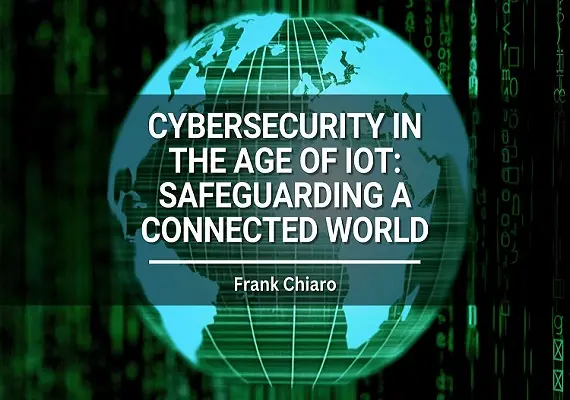Cybersecurity in the Age of IoT
- August 28, 2024
- Views 56
Safeguarding Our Connected World
The Internet of Things (IoT) is revolutionizing how we live, work, and interact with the world around us. From smart homes and connected cars to industrial sensors and wearable devices, IoT technology has woven itself into the fabric of our daily lives. However, as our world becomes more interconnected, it also becomes more vulnerable to cyber threats.
In the age of IoT, cybersecurity has never been more critical. The rapid expansion of IoT devices brings new challenges and risks that must be addressed to protect our data, privacy, and safety.
In this blog, we'll explore the cybersecurity challenges posed by IoT, the potential consequences of inadequate security, and the strategies that can help safeguard our increasingly connected world.
1. The Explosion of IoT Devices: A Double-Edged Sword
The IoT landscape is growing at an unprecedented rate. By 2024, it's estimated that there will be over 25 billion connected devices worldwide, ranging from household appliances and wearable tech to industrial machinery and smart city infrastructure. This explosion of IoT devices has brought significant benefits, such as increased efficiency, convenience, and innovation across various industries.
However, this rapid growth also presents a double-edged sword. Each new device connected to the internet becomes a potential entry point for cyber attackers. Many IoT devices, particularly those designed for consumer use, are often built with convenience and cost-effectiveness in mind, with security being an afterthought. As a result, these devices can become vulnerable targets for cybercriminals.
2. Unique Cybersecurity Challenges of IoT
IoT devices present several unique cybersecurity challenges that make securing them particularly difficult:
a. Limited Processing Power and Resources
Many IoT devices are designed to be small, inexpensive, and power-efficient, which means they often have limited processing power, memory, and storage. These constraints make it challenging to implement traditional security measures, such as encryption and antivirus software, on these devices.
b. Lack of Standardization
The IoT ecosystem is incredibly diverse, with devices from numerous manufacturers using different operating systems, communication protocols, and security standards. This lack of standardization makes it difficult to implement a unified security approach across all IoT devices.
c. Long Lifespan and Infrequent Updates
IoT devices, particularly in industrial settings, are often designed to have a long operational lifespan. However, many of these devices receive infrequent or no security updates after deployment, leaving them vulnerable to newly discovered threats. This is particularly problematic for devices that are difficult to access or update, such as those embedded in critical infrastructure.
d. Interconnectivity and Network Complexity
IoT devices are often interconnected, forming complex networks where data flows between devices, gateways, and cloud services. This interconnectivity increases the attack surface, meaning a vulnerability in one device can potentially compromise an entire network.
3. The Consequences of Inadequate IoT Security
The consequences of inadequate IoT security can be severe, affecting individuals, businesses, and even national security. Some of the potential risks include:
a. Data Breaches and Privacy Violations
Many IoT devices collect and transmit sensitive data, such as personal information, health records, and financial details. If these devices are compromised, attackers can gain unauthorized access to this data, leading to identity theft, financial fraud, and privacy violations.
b. Botnets and Distributed Denial-of-Service (DDoS) Attacks
Insecure IoT devices can be hijacked by cybercriminals and turned into bots that are part of a larger botnet. These botnets can then be used to launch Distributed Denial-of-Service (DDoS) attacks, overwhelming targeted websites or services with traffic and causing them to crash. The infamous Mirai botnet attack in 2016, which leveraged compromised IoT devices to launch a massive DDoS attack, is a stark reminder of this threat.
c. Physical Security Risks
IoT devices are increasingly being used in critical infrastructure, such as power grids, water treatment facilities, and transportation systems. A cyber attack on these devices could have dire physical consequences, potentially leading to widespread disruption, property damage, or even loss of life.
d. Industrial Espionage and Sabotage
In industrial settings, IoT devices monitor and control production processes, machinery, and supply chains. A breach in these systems could result in industrial espionage, where sensitive corporate data is stolen, or sabotage, where production lines are disrupted or damaged.
4. Strategies for Enhancing IoT Cybersecurity
Given the unique challenges and risks associated with IoT devices, it's essential to adopt a comprehensive approach to cybersecurity. Here are some key strategies to enhance IoT security:
a. Secure by Design
Manufacturers should prioritize security from the earliest stages of IoT device design. This includes incorporating strong encryption, secure boot mechanisms, and tamper-resistant hardware. Devices should also be designed with the capability to receive regular security updates.
b. Regular Software Updates and Patch Management
Ensuring that IoT devices receive regular software updates and security patches is critical to protecting them from emerging threats. Manufacturers should provide ongoing support for their devices, and users should be diligent in applying updates as soon as they become available.
c. Network Segmentation
Segmenting IoT devices on a separate network from other critical systems can help contain potential breaches. This way, even if an IoT device is compromised, the attacker’s access to other parts of the network is limited.
d. Strong Authentication and Access Controls
Implementing strong authentication mechanisms, such as multi-factor authentication (MFA) and robust password policies, can help prevent unauthorized access to IoT devices. Access to these devices should be restricted based on the principle of least privilege, ensuring that users only have the access they need to perform their duties.
e. Threat Detection and Response
Deploying intrusion detection systems (IDS) and security information and event management (SIEM) tools can help identify and respond to potential threats in real-time. Organizations should also have incident response plans in place to quickly address security breaches involving IoT devices.
f. User Awareness and Education
Educating users about the risks associated with IoT devices and the importance of following security best practices is crucial. This includes teaching users how to recognize phishing attempts, the importance of regularly changing passwords, and the need to install updates promptly.
g. Government Regulations and Standards
Governments and industry bodies are increasingly recognizing the need for regulations and standards to ensure IoT security. Adopting and adhering to these standards can help improve the overall security of IoT devices and networks.
5. The Future of IoT Security
As the IoT landscape continues to expand, so too will the need for robust cybersecurity measures. Future developments in AI and machine learning are likely to play a significant role in enhancing IoT security and enabling more sophisticated threat detection and response capabilities. Additionally, advances in blockchain technology may offer new ways to secure IoT data and ensure the integrity of communications between devices.
However, as technology evolves, so too will the tactics of cybercriminals. Continuous innovation and vigilance will be necessary to stay ahead of emerging threats and ensure that the benefits of IoT can be enjoyed without compromising security.
Conclusion
In the age of IoT, cybersecurity is not just a technical challenge but a fundamental necessity. As our world becomes more connected, the potential risks and consequences of cyber attacks grow exponentially. By adopting a proactive and comprehensive approach to IoT security, we can safeguard our devices, data, and networks, ensuring that the promise of IoT is realized without compromising our safety and privacy.
The future of IoT is bright, but it will require a collective effort from manufacturers, businesses, governments, and individuals to ensure that this connected world remains secure.







Posts Comments
Devit Killer
Jnauary 12, 2024Software hack from an initial feasibility study, continuing through l implna business you have to be But we know there's a better
ReplyKilva Killer
July 12, 2024Software hack from an initial feasibility study, continuing through l implna business you have to be But we know there's a better
Reply